Are You Pumped Up?
When it comes to choosing a pump, it’s easy to feel as though you’re being flooded with choices. With so many factors to consider and a variety of pumps from which to choose, it can seem overwhelming to make the right decision. From centrifugal to trash to diaphragm, there are several different types of pumps out there, each suited to match specific needs.
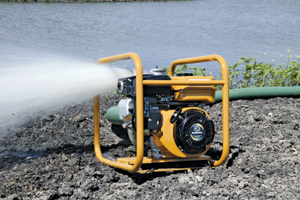
Choosing an incorrect pump can result in poor performance and damage to the pump’s components. Pumps should be selected based on the type of water being moved. But what makes a certain type of water acceptable for one pump but not for another? How do you differentiate slightly dirty water from debris-littered water? To accurately choose the best pump for the job, the user must look below the surface and investigate what is actually in the water.
The Clear Choice
For applications where clean water must be moved, centrifugal pumps offer the best and most inexpensive means to do so.
As the name implies, centrifugal force drives the operation of a centrifugal pump by moving water away from the center in a circular motion. An impeller within the pump drives this centrifugal force. With each rotation of the impeller, velocity is increased, which causes the liquid to move into the volute. The velocity is reduced within the volute and its energy converted to pressure energy. This allows the fluid to be quickly forced from the pump.
Centrifugal pumps have narrow impeller vanes, making clear water that is virtually free of debris the only type of water this pump is able to handle. Obviously there is always a chance that seemingly clear water will contain at least a small amount of debris. This is why these pumps are equipped with a strainer, which acts as a safety net and stops unforeseen debris from entering the intake hose.
Draining swimming pools and flooded basements, along with powering sprinklers, de-watering jobsites and moving water into drinking bins for animals are all examples of where this pump would do a fine job.
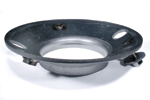
When Centrifugal Won’t Pump It
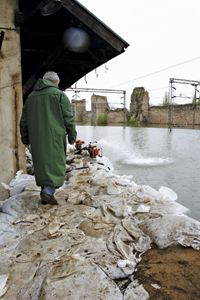
A semi-trash pump should be used in any situation where there is uncertainty that a centrifugal pump will be able to handle the job. Water that appears a bit dirty or sandy should be moved using this type of pump. If there is even a hint of debris, err on the side of caution and go with a semi-trash pump.
While a semi-trash pump is capable of handling more than a centrifugal pump, it can still have problems if the debris is too large. It is also incapable of handling sticks, stones or concrete particles. If a user detects any of those types of debris in the water, he or she should opt for the next level of pump — a trash pump.
Sticks and Stones Won’t Break These Bones
For items that are too big for a semi-trash pump to handle, a trash pump would be the best choice. With even thicker vanes than a semi-trash pump and the same large volute discharge opening, a trash pump operates the same way but allows larger debris to flow through.
Small sticks, stones and other debris from ¾ of an inch to 1 ¼ of an inch, or up to the size of a half dollar coin can successfully go through a trash pump. This makes it ideal to handle thicker, sandier and dirtier water than a semi-trash pump.
These pumps are a good choice for situations where high volumes of water that may contain trash need to be moved, especially if there is uncertainty that the debris would be too large to be handled by a semi-trash pump. Pumping water from construction or agricultural sites is an example of an application that may require a trash pump.
A trash pump can definitely handle thicker water and fairly large debris, but what about really muddy or viscous water that may contain larger solids, trash or other particles? Or water that is so thick, it’s almost impossible to detect what kinds of debris may be submerged? For the toughest water with large debris, a diaphragm pump will handle it best.
Diagnosis for Diaphragm
Often referred to as “mud hogs” or “mud pumps,” the diaphragm pump is the one to choose when the water is so thick or dirty that the user cannot detect what may be lurking underneath the surface.
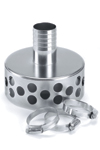
Diaphragm pumps are capable of handling sticks, stones, mud, trash and other debris up to 2 in., or a bit larger than the size of a golf ball. Basically, anything that can fit through the opening will be able to go through. It will pump seawater, re-circulated water and muddy, sandy and viscous water.
All these capabilities mean a higher price tag for this type of pump. For this reason, a diaphragm pump is typically used only when it is the sole machine that can handle the job. And it operates at a slower rate than the others, so be prepared for the job to take a bit longer if using this type of pump. For instance, a 3-in. trash pump will move water at a rate of about 315 gpm, compared with a 3-in. diaphragm pump, which will only move water at a rate of about 60 to 70 gpm.
By now, the user should be ready to choose a pump based on the type of liquid being moved. But before he or she sets foot in any stores, there are a few more factors to think about.
All Things Considered
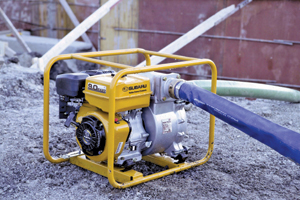
Furthermore, be sure to compare the quality between pumps. While it may be tempting to save money and skimp on features, having a higher quality pump that withstands time and abuse will pay for itself in the long run. Because the engine is the driving force behind the pump, it is important for it to be high quality and long lasting. Additionally, the pump housing, impeller and volute are essential to superior operation, so be sure they are well made and not plastic. Some manufacturers equip trash pumps with a wear plate, which absorbs the impact of sticks, stones and other large debris before they enter the impeller. This is a valuable feature that can ensure a longer life for the pump, while reducing maintenance requirements. Finally, lower quality pumps often don’t have frames. Choose a pump with a quality frame to protect the pump, engine and all components.
Finally, check the maintenance requirements of each pump. Regardless of how high quality the pump is and how well suited it is for the job, a pump that is not properly maintained will likely cause work interruptions and result in the need for expensive repairs. Select a pump that is easy to maintain and requires only minimal professional attention. Be sure to follow through with maintenance to help prolong the life of the pump.
With so many pumps available, it can be difficult to know if you are using the correct one. Improper selection may result in unsatisfactory performance of the pump, not to mention possible damage to the machine’s components. Having knowledge of each type of pump and more importantly, what is in the water being pumped, will ensure the best selection is made for the job at hand.
Pam Meyer is an equipment sales manager with Subaru, based in Lake Zurich, Ill.


Comments are closed here.